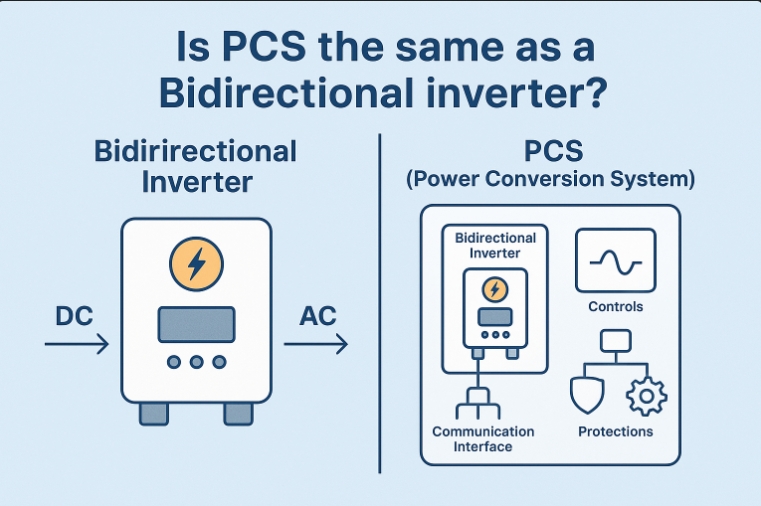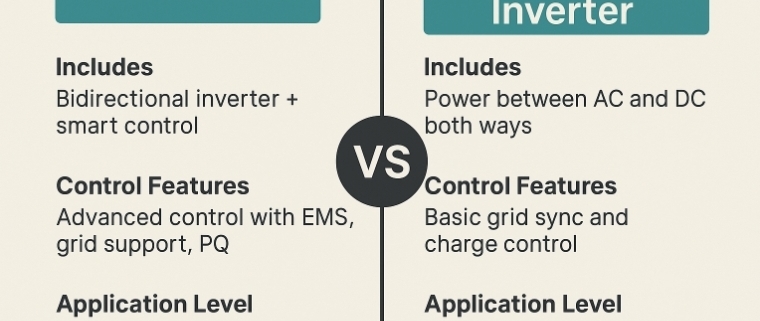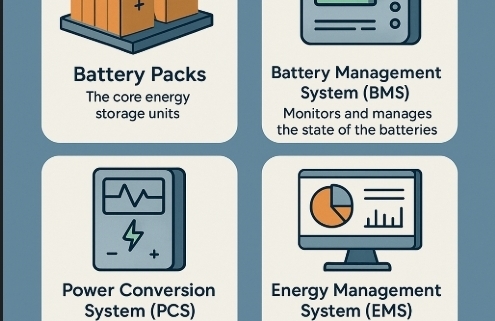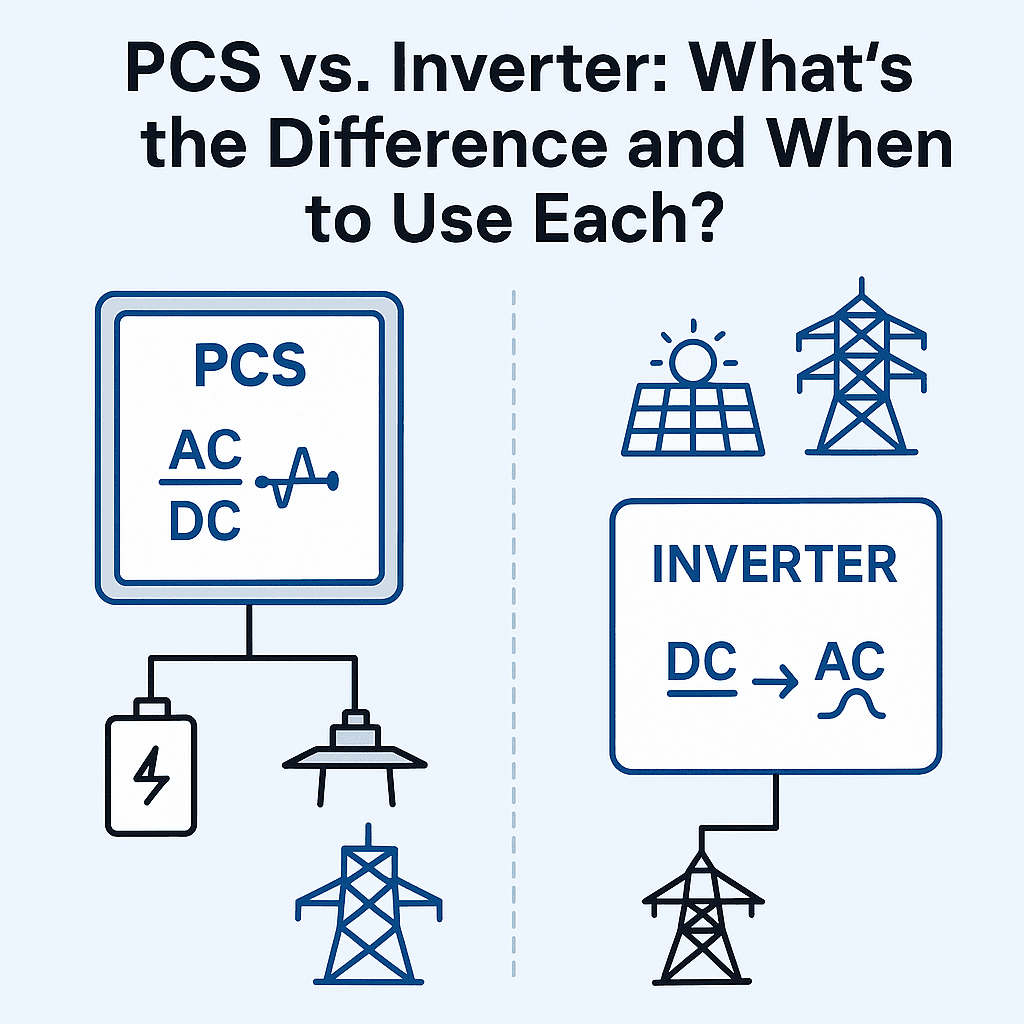Bidirectional Inverter vs PCS: Understanding the Differences, Functions & Usage
Bidirectional Inverter vs PCS: In the evolving world of energy systems, both Bidirectional Inverters and Power Conversion Systems (PCS) play a critical role—especially in energy storage systems (ESS), microgrids, and renewable power integration. While they appear similar in functionality, they are not interchangeable. In this blog, we break down every point of comparison, explain how each works, and where they are best used.
🔌 What Is a Bidirectional Inverter?
✅ Functions of Bidirectional Inverter:
- AC to DC Conversion: Converts grid AC to DC to charge batteries.
- DC to AC Conversion: Converts stored DC back to AC to supply the load or feed the grid.
- Grid Synchronization: Ensures power output is matched in voltage, frequency, and phase with the grid.
- Battery Management Communication: Works with BMS to control charging/discharging safely.
⚙️ Usage Areas:
- Home and commercial solar + battery systems
- Microgrids
- EV charging stations with V2G (Vehicle to Grid)
- UPS systems with grid-tie capability
⚡ What Is a PCS (Power Conversion System)?
A PCS, or Power Conversion System, is a more comprehensive solution. It usually includes bidirectional inverter functionality, plus additional components such as:
- Grid-interfacing controller
- Communication interfaces
- Safety protections
- Advanced energy management algorithms
✅ Functions of PCS:
- Bidirectional Power Flow: Handles charging and discharging like a bidirectional inverter.
- Energy Management: Integrates with EMS (Energy Management System) for dynamic power flow.
- Power Quality Control: Manages frequency, reactive power, and voltage.
- Multi-port Control: Can connect multiple DC sources (PV, battery, etc.).
- Islanding and Black Start: Supports off-grid operation and black start capability.
⚙️ Usage Areas:
- Grid-scale Battery Energy Storage Systems (BESS)
- Utility and Industrial Microgrids
- Renewable Power Plants with storage
- Critical infrastructure backup systems
🆚 Key Differences Between Bidirectional Inverter and PCS

| Feature | Bidirectional Inverter | PCS (Power Conversion System) |
|---|---|---|
| Basic Function | Converts power between AC and DC both ways | Includes bidirectional inverter + smart control |
| Control Features | Basic grid sync and charge control | Advanced control with EMS, grid support, PQ |
| Application Level | Residential / Small Commercial | Utility / Industrial / Large BESS |
| Grid Services Support | Limited | Yes – can provide FFR, voltage regulation |
| Communication Protocols | Basic – BMS, inverter | Advanced – EMS, SCADA, Modbus, CAN, etc. |
| Expandability | Limited | Scalable for multi-MW systems |
| Cost | Lower | Higher due to additional features |
🎯 Which One Should You Use?
Choose Bidirectional Inverter if:
- You’re setting up a home or small commercial ESS.
- You need basic backup power and solar integration.
- Budget is limited and advanced control isn’t a priority.
Choose PCS if:
- You’re deploying a grid-scale battery system.
- You need integration with grid operations or islanding capabilities.
- You require smart control, power quality management, or multiple energy inputs.
📌 Bidirectional Inverter vs PCS: Real-World Example
Home System with Bidirectional Inverter:
A solar home with a 10 kWh lithium battery uses a bidirectional inverter to charge the battery during the day and power the home at night. It synchronizes with the grid and works with a BMS.
Utility-Scale PCS Example:
A 2 MW/4 MWh battery system at a wind farm uses PCS to manage energy injection into the grid during peak demand, support frequency regulation, and provide backup during outages.
🧠 Bidirectional Inverter vs PCS: Final Thoughts
Both Bidirectional Inverters and PCS are essential in the shift toward smarter, more resilient power systems. However, understanding their differences in function, scale, and intelligence is crucial before choosing the right solution.
In summary:
- Use Bidirectional Inverter for basic energy conversion and storage in smaller systems.
- Use PCS for smart, scalable, and grid-integrated power management in large or complex setups.
Bidirectional Inverter vs PCS FAQ
Q1: Is PCS the same as a bidirectional inverter?
Q2: Can I use PCS for residential use?
A: Technically yes, but it’s usually overkill in terms of cost and capability. A bidirectional inverter is more suitable.
Q3: What is the advantage of PCS in utility-scale projects?
A: PCS enables grid-forming functions, power quality control, and integrates with SCADA/EMS systems, which are essential for large energy operations.




